How To Get Your Cat To Like You More
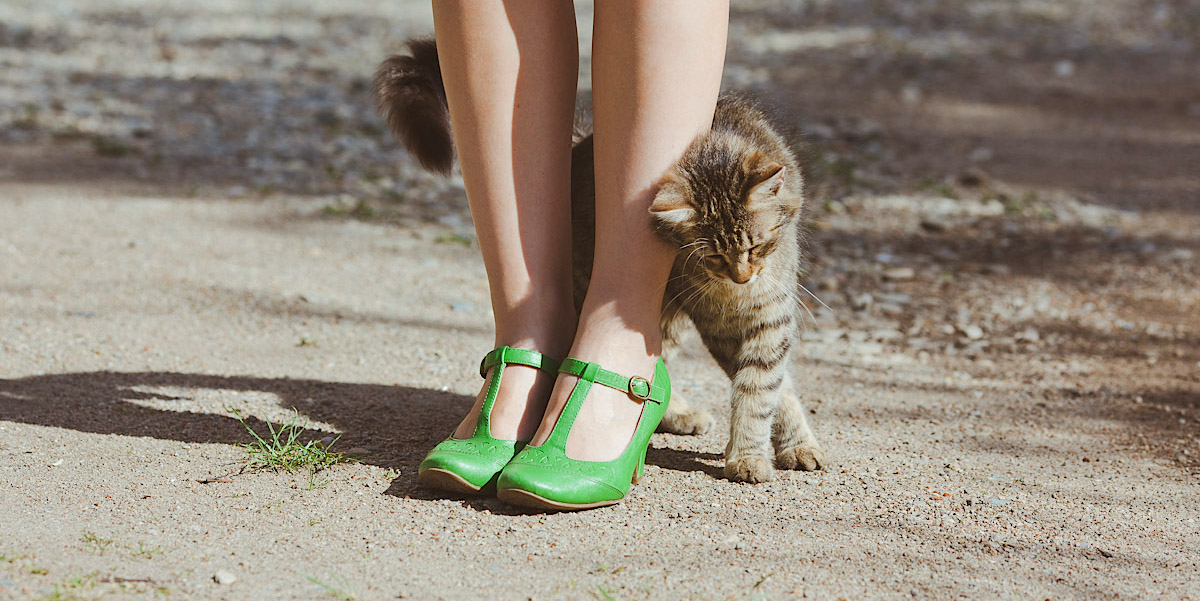
Ah, cats.. life’s biggest mystery. What are they thinking? Why are they doing that? …Why don’t they like me?? Ever had thoughts like these? I obviously haven’t. (Jk).
I’ve always found cats to be open books—if they want attention, they’ll make it known (perhaps a little too fervently). And when they don’t, you can bet your ass they’ll let you know as well. And there lies the key to inspiring unconditional kitty devotion: knowing how to read their signals, and interacting with them accordingly.
If you’re a new cat owner hoping to help a new family member transition into your home, this should be a useful guide. If you’re already a seasoned cat wrangler with an aloof kitty in your care, some of these tips should help take the edge off.
A solid foundation of happy
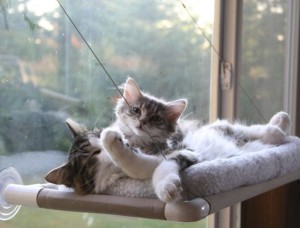 Before we get into the nitty gritty, make sure you’ve laid the groundwork for healthy, happy furballs: by playing with them often, ensuring they’ve got plenty of vertical space (I know I sound like a broken record with the incessant talk of “vertical space,” but srsly, it’s important), providing comfy resting places tucked away around the house, and feeding them a high quality, protein-based diet. Kitties need to have these basic needs met before they’ll feel secure enough to develop healthy attachments.
Before we get into the nitty gritty, make sure you’ve laid the groundwork for healthy, happy furballs: by playing with them often, ensuring they’ve got plenty of vertical space (I know I sound like a broken record with the incessant talk of “vertical space,” but srsly, it’s important), providing comfy resting places tucked away around the house, and feeding them a high quality, protein-based diet. Kitties need to have these basic needs met before they’ll feel secure enough to develop healthy attachments.
Everything in place? Then let’s proceed to the next step—
Ignore the shit out of them.
“Wtf that’s so.. mean,” you think to yourself. Ok, you shouldn’t actually ignore the shit out of your cats. But if you have a standoffish or irritable kitty, you could probably stand to go a little more extreme in this department. Ever heard that old adage that cats will find the one person in the room who doesn’t like cats, and gravitate towards them? There’s actually a good reason for this behavior.
Cats are choosy critters. They love attention, but on their own terms (which is probably why they love it when you’re trapped on the toilet). They rarely like being approached uninvited, even for affection. They want to do the seeking. They want to invite themselves into your personal space. This arrangement don’t go both ways, honey-*sassy finger snap*.
Ok, so hold back a little. But how?
 When you get home, resist the (overwhelming, granted) urge to drop your bags and make a beeline for your snoozing kitties. Don’t scoop them up, don’t smush their faces, don’t bury your nose into their downy underbellies. In fact, don’t seek them out at all.
When you get home, resist the (overwhelming, granted) urge to drop your bags and make a beeline for your snoozing kitties. Don’t scoop them up, don’t smush their faces, don’t bury your nose into their downy underbellies. In fact, don’t seek them out at all.
Speak a soft, calm word of greeting so they know it’s you walking through the door, and then carry on with your after work routine. Let them come to you. If they do come to you voluntarily, feel free to give them affection.
In day to day life, try not to resort to chasing your cats down or digging them out from under the sofa when you’re just dying to cuddle their fat little bums. Wait until they come to you. Or at the very least, wait until they’re in a calm state of mind and open to affection.
How the heck do I know when they’re open to affection?
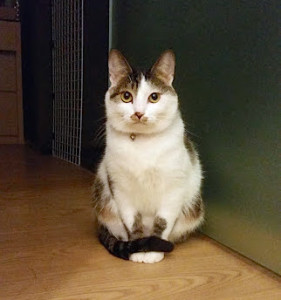
My mom’s cat Flower, demonstrating a perfect “Look don’t touch, please.”
A cat sitting with its back against a wall, tail curled up neatly by its side, likely doesn’t want to be touched.
A good rule of thumb here: the more appendages you see tucked away near their bodies or out of sight, the less your cat wants to be interacted with.
It’s like human body language in that way, where your crossed legs and crossed arms are telling the world, “Oy. Leave me alone.” And if your kitty’s tail is thrashing from side to side, that’s an ever surer sign that they’re feeling irritated and don’t want to be bothered.
A kitty open to interaction will lie in a relaxed position, taking up more space, looking at you with sleepily narrowed eyes. If their eyes begin to widen as you approach, abort mission. A receptive kitty on the move will be marching about confidently with her tail held high; even better, she’ll rub up against your leg.
Speak softly.
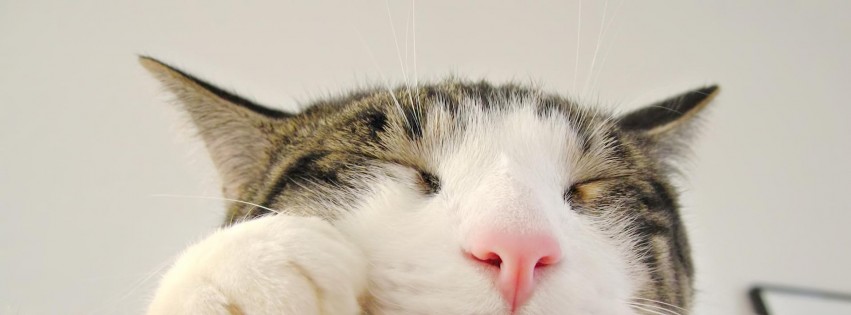
Like the grumpy old men they are, cats don’t like loud noises. Or high pitched squealing. Or squealing of any sort, really. Even when you’re overcome with their face-scrunching cuteness, try to keep your voice to a low, soothing gurgle. Like a crowd of pigeons cooing—that low, melodic, reassuring hum.
When I catch Sita walking by, I can often stop her in her tracks with a soft, affectionate, “Hey, girl.” She sits down and faces me, blinks slowly, and wiggles her tail with delight. It’s stupidly adorable. (And Sita’s not a naturally affectionate cat. She’s kind of a dick. But even she goes nuts for low, soothing vocal intonations.)
Respect their boundaries.
Most cats have a snuggling threshold. Once they’ve reached it, they’ll attempt to wriggle out of your arms (or perhaps claw you in the face.. the turds). Try not to let a snuggle session degenerate to the point where your cats feel the need to fight you off, or thwart your continued affection.
I gradually built up Sita’s tolerance to being held by putting her down (slowly and gently) the moment I sensed her start to push away from me. Over time, she learned that being picked up didn’t spell a torturous half hour of smothering entrapment. When she felt assured in the knowledge that she was free to go whenever she pleased, she subsequently no longer resisted being picked up or held.
This tactic may have worked a little too well, actually. Now she spends hours curled up on my chest in a zen little loaf while I try to navigate my computer screen over the top of her head.
A note on kitty holding
This doesn’t necessarily apply to every cat, but can be helpful if your kitty happens to be a mega-reluctant cuddler. When you pick up your cats, make sure you’re not holding them like they’re infants (cradled in your arms, belly up). Some cats dig this, but the ones who don’t, really don’t. It makes them feel vulnerable—for the very same reasons why most cats will maul you when you try to pet their irresistibly floofy exposed bellies.
Hold them so they’re upright, whether that means making a “basket” with your arms they can sit or lie in, or leaning them lean over your shoulder like you’re burping a baby.
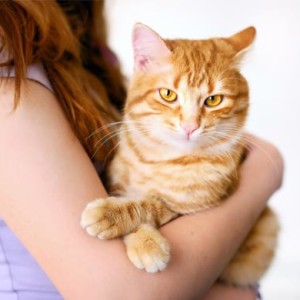
Yes cat

No cat
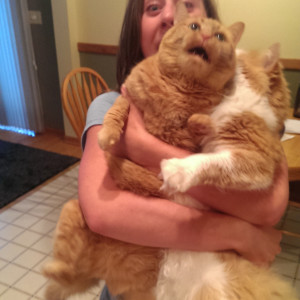
Why cat
Another note on kitty holding
You don’t necessarily have to pick up your cats to bond with them. My cats love when I reach down to pet them and give them long, massage-y scratches down the length of their back (never against the direction of their fur growth), all while their feet stay squarely and reassuringly planted on the ground.
This “grooming” behavior soothes them and builds their trust in you. Even when they’re nice and relaxed from the scritches, try to refrain from picking them up. Do this enough, and they’ll soon be proactively seeking you out for affection.
The ole slow blink
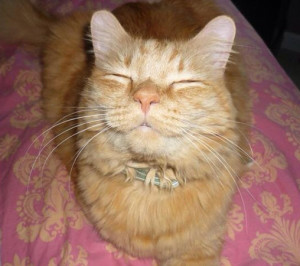 Next time you catch your kitty staring at you like a serial killer (as they are fond of doing), try blinking slowly at her. At first, kitty may look away uncomfortably—but don’t be discouraged.
Next time you catch your kitty staring at you like a serial killer (as they are fond of doing), try blinking slowly at her. At first, kitty may look away uncomfortably—but don’t be discouraged.
A kitty slow blink is the ultimate sign of intimacy, trust and affection, and she may not be ready for the big leagues. Keep it up (but not, you know, obsessively) and you’ll find that she eventually returns the gesture. And what a day that will be!
Lackluster results?
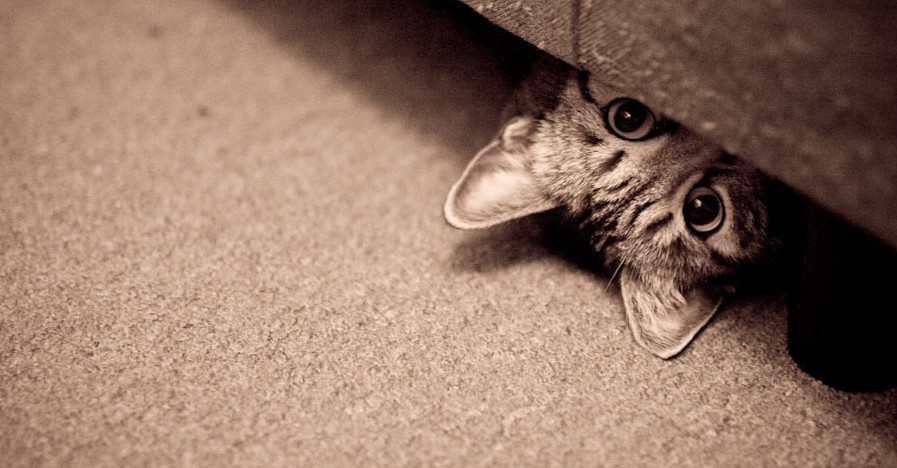
If none of this seems to work and kitty still refuses to go hurtling into your arms, just remember that cat personalities are as diverse as our own. Some cats just aren’t the touchy-feely type, and it certainly doesn’t mean they don’t adore you.
Look carefully, and you’ll notice that they’re still sending you subtle signs of love. Like those long, slow blinks from across the room. Or when they sit quietly (just out of arm’s reach) in your vicinity—just so they can be in your presence. Or when they leave dead animals on your doorstep (..that got dark fast). Sita used to catch flies and leave their lifeless carcasses on the arm of my sofa.
Still, even without seeing instant improvement in your cat’s demeanor, it’s always a good idea to remain cognizant of your kitty’s body language and respect their boundaries. Your cats know when they’re loved and respected, and will show their appreciation any way they know how.
Let’s recap!
Right, so this is a lot to take in. In summary:
How to get your cats to like you more?
- Fulfill all their basic health, security, and comfort needs, to start.
- Don’t shower them with attention the moment you return home.
- Let them come to you before giving affection.
- Speak to them in soft, soothing low tones.
- Try not to hold them with their bellies exposed.
- Give them plenty slow blinks and back scratches without picking them up.
- When you do pick them up, let them come and go as they please.
Got any of your own tips for wooing grumpy kitties? Had luck with any of these strategies? Let me know!
Check out the rest of this series!
How to get your cat to stop liking you so much
&

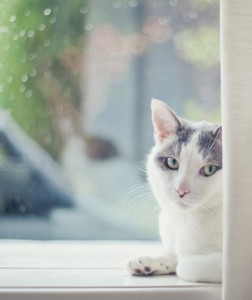 I gradually built up Sita’s tolerance to being held by putting her down (slowly and gently) the moment I sensed her start to push away from me. Over time, she learned that being picked up didn’t spell a torturous half hour of smothering entrapment. When she felt assured in the knowledge that she was free to go whenever she pleased, she subsequently no longer resisted being picked up or held.
I gradually built up Sita’s tolerance to being held by putting her down (slowly and gently) the moment I sensed her start to push away from me. Over time, she learned that being picked up didn’t spell a torturous half hour of smothering entrapment. When she felt assured in the knowledge that she was free to go whenever she pleased, she subsequently no longer resisted being picked up or held.


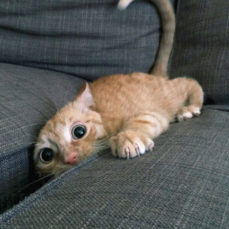


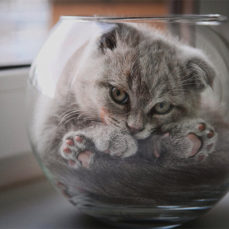
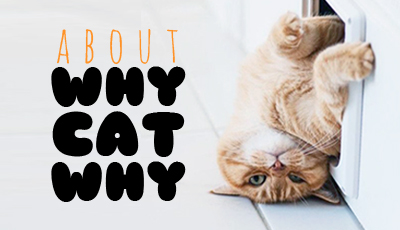
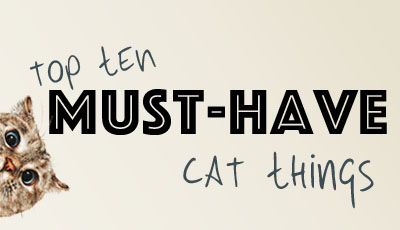

My cat will 3/4of the time lay next to me, wanting me to pet her before she lays down on her cushion in my bedroom. I once tried ignoring her and she dug her claws in deep in my arm and growled. The petting sessions last ranging from 5-10 minutes.